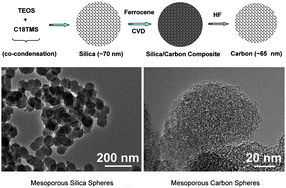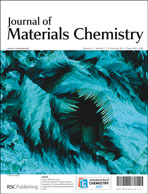Mesoporous carbon nanospheres (MCS) with particle size of about 65 nm and primary mesopores of about 2.7 nm in diameter were prepared and used as supercapacitor electrodes. Ferrocene was employed as the carbon precursor and mesoporous silica nanospheres were used as the template. High-resolution transmission electron microscopy revealed that the MCS consisted of graphene sheets in small domains and exhibited a specific surface area and pore volume of 2396 m2 g−1 and 2.9 cm3 g−1, respectively. The electrocapacitive performance of the MCS electrode was investigated by using cyclic voltammetry, galvanostatic charge–discharge, and electrochemical impedance spectroscopy techniques with both aqueous and non-aqueous electrolytes. The mesopores and short length of the MCS electrode were found to favor the diffusion of electrolyte ions. A symmetric supercapacitor with the MCS as the electrodes exhibited a specific capacitance of 180 F g−1 and delivered energy densities of 62.8 W h kg−1 and 9.1 W h kg−1 at power densities of 0.16 kW kg−1 and 32 kW kg−1, respectively, in a 1.5 mol L−1tetraethylammonium tetrafluoroborate in acetonitrile electrolyte. In addition, the MCS supercapacitor displayed a good cyclability, with 78% energy density and more than 90% power density remained after 700 cycles at a current density of 3.0 A g−1.

You have access to this article
 Please wait while we load your content...
Something went wrong. Try again?
Please wait while we load your content...
Something went wrong. Try again?


 Please wait while we load your content...
Please wait while we load your content...